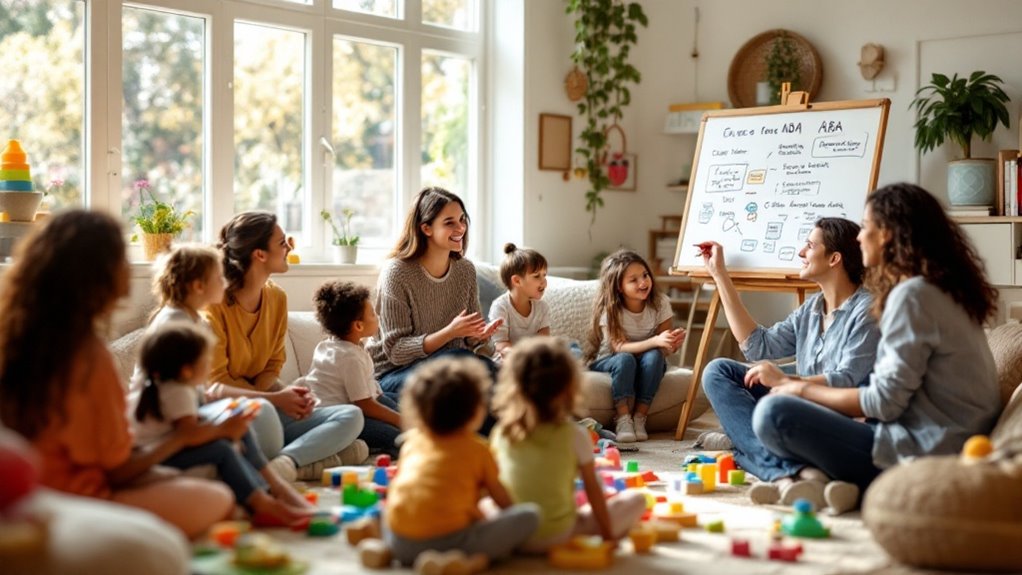If you're considering ABA therapy for your child, you might have some burning questions. You'll want to know how effective it really is, what a typical session looks like, and how to choose the right provider for your family. You may also wonder about the costs involved and what kind of outcomes you can expect. The good news? ABA therapy can lead to significant improvements in communication and social skills, especially when families get actively involved. As you explore, you'll uncover valuable insights and tips that can help you on this journey for your child's growth.
Key Takeaways on the Effectiveness of ABA Therapy for Children
- ABA therapy is effective for children with autism, showing significant improvements in communication, social skills, and overall functioning through structured approaches.
- Individualized treatment plans are essential, as each child's strengths and challenges are assessed to create tailored strategies aligned with their interests.
- A typical session includes warm-up activities, targeted skill practice, and feedback, ensuring a structured yet engaging learning environment.
- Parent involvement enhances therapy effectiveness, as regular communication and training empower families to support their child's progress at home.
- Costs for ABA therapy vary by insurance coverage and therapy intensity, with resources available to help families manage expenses effectively.
What Is ABA Therapy?

When you hear the term ABA therapy, you might picture a child engaged in fun activities while learning essential skills. That's a great start, but there's so much more to it! ABA, or Applied Behavior Analysis, uses specific ABA techniques to help individuals, especially children with autism, improve their social, communication, and learning skills.
You might've heard some therapy misconceptions, like thinking ABA is all about rote learning or that it's purely about compliance. But it's not just about following rules; it's about understanding behavior. By analyzing how a child reacts to different situations, therapists can tailor interventions to encourage positive behaviors and reduce challenging ones.
Imagine a therapist observing a child playing and noticing that they respond well to praise. They'll then use that insight to create a personalized plan that incorporates more encouragement, making learning feel like a game rather than a chore.
This approach helps kids thrive in real-world settings, building their confidence along the way. So, when you think of ABA therapy, remember it's not just fun activities—it's a powerful tool for growth and development!
How Effective Is ABA Therapy?
When you think about ABA therapy, you might wonder just how effective it really is for your child.
With research-backed outcomes and personalized treatment plans, many families see remarkable progress, especially in developing essential life skills.
It's not just about quick fixes; it's about laying a foundation for long-term success.
Research-Based Outcomes
ABA therapy has gained recognition for its effectiveness in helping children with autism spectrum disorder (ASD) achieve meaningful progress. You might be wondering, what makes it so effective? Well, it all boils down to evidence-based practices and careful data collection.
Imagine a child learning to communicate more effectively. Through ABA, therapists use specific strategies tailored to your child's unique needs, breaking down skills into manageable steps. They closely monitor progress, collecting data to see what works and what doesn't. This isn't just guesswork; it's a structured approach that allows for adjustments based on real results.
Think of it like a coach analyzing a game. They track every play to enhance performance. Similarly, ABA therapists track behavioral changes, ensuring that each session builds on the last. You'll see your child's achievements, whether it's making eye contact, following instructions, or engaging in social interactions.
Thanks to these research-based outcomes, many families report significant improvements in their children's behaviors and skills.
Individualized Treatment Plans
Every child's journey in ABA therapy is uniquely tailored, ensuring their specific needs and strengths are front and center. This personalization is what makes ABA so effective. You're not just following a one-size-fits-all approach; instead, you're working towards individual preferences and treatment goals that resonate with your child.
Here's how individualized treatment plans come together:
- Assessment: Each child undergoes a thorough assessment to identify their unique strengths and challenges.
- Collaboration: You'll work closely with the therapist to set realistic and meaningful treatment goals that align with your child's interests.
- Flexibility: As your child progresses, the plan is flexible and can adapt based on their evolving needs and preferences.
- Measurement: Regular data collection helps track progress, ensuring that the treatment remains effective and aligned with your child's individual goals.
Long-Term Skill Development
Long-term skill development is a cornerstone of effective ABA therapy, shaping not just immediate behaviors but laying the groundwork for lifelong success.
Imagine your child learning to communicate their needs more effectively. That's not just a win for today; it's a skill that will serve them throughout their life.
As you engage in ABA therapy, you'll notice how it emphasizes skill retention. Your child won't just memorize a behavior for a short time; they'll learn strategies that stick.
This focus on long-term benefits means that skills are practiced in various settings, reinforcing their importance in everyday life.
Let's say your child learns to ask for help when they're struggling. That's a powerful life skill! They'll carry that ability into school, friendships, and even future jobs.
Each session builds not only on what they've learned but also instills confidence, allowing them to tackle new challenges.
Ultimately, the journey of ABA is about more than just behavior modification; it's about empowering your child to thrive.
What Does a Typical Session Involve?

Have you ever wondered what happens during a typical ABA therapy session? Well, it usually follows a structured approach designed to maximize learning while keeping things engaging for your child. Here's a sneak peek into what you can expect:
- Warm-Up: The therapist starts with a brief, fun activity to help your child feel comfortable and build rapport. This sets a positive tone for the session.
- Targeted Skills: The core of the session focuses on teaching specific skills. The therapist utilizes various techniques like modeling or reinforcement, adapting their approach based on your child's unique needs.
- Generalization Opportunities: The therapist encourages your child to practice skills in different settings. This helps them use what they've learned in real-life scenarios, making it more meaningful.
- Feedback and Reflection: At the end of the session, the therapist discusses progress with you, sharing insights on what's working and areas that may need more focus.
Who Provides ABA Therapy?
When you're exploring ABA therapy for your child, it's crucial to know who's behind the scenes making it all happen. The heart of ABA therapy lies in the hands of certified professionals—those who've dedicated their careers to understanding behavior and implementing effective strategies.
These experts typically hold credentials like the Board Certified Behavior Analyst (BCBA) designation, which signifies they've undergone rigorous training and passed thorough exams.
Imagine your child's therapist as a guide on a journey. They assess your child's unique needs and craft a personalized plan to promote learning and growth. This isn't just anyone stepping into the role; these professionals have a deep understanding of behavioral principles, ensuring they're equipped to tackle challenges head-on.
Alongside BCBAs, you may also encounter Registered Behavior Technicians (RBTs). These trained individuals work under the supervision of BCBAs to deliver interventions, making sure every session is impactful.
Knowing that certified professionals with solid therapy credentials are working with your child can provide peace of mind. You want the best for your little one, and the right team makes all the difference in their development and success.
How to Choose an ABA Provider?

Finding the right ABA provider for your child can feel overwhelming, especially after understanding the vital roles of BCBAs and RBTs.
You want to guarantee your child receives the best care possible, so here are some key factors to evaluate:
- Provider Qualifications: Check if the provider has certified BCBAs and trained RBTs. Their credentials matter for effective therapy.
- Service Accessibility: Look for providers who offer services that fit your family's schedule and location. Distance shouldn't be a barrier to your child's progress.
- Customized Treatment Plans: It's essential that the provider tailors their approach to your child's unique needs. A one-size-fits-all strategy rarely works in ABA therapy.
- Parent Involvement: Choose a provider that encourages your participation in the therapy process. Your insights are invaluable, and being involved can enhance your child's outcomes.
What Are the Costs of ABA Therapy?
Understanding the costs of ABA therapy can feel like maneuvering through a maze, especially when you're trying to prioritize your child's needs. With so many factors at play, you might find yourself wondering how to budget effectively.
First things first: insurance coverage can make a significant difference. Many plans cover ABA therapy, but it's important to check what's included. You'll want to confirm if your provider is in-network and what your co-pays look like. Often, the more intensive the therapy, the higher the costs.
Speaking of intensity, therapy duration plays a critical role in overall expenses. Some families opt for a few hours a week, while others might invest in more thorough support. The longer the therapy, the more it can add to your bill—but this investment can pay off in your child's development.
As you navigate these costs, remember that you're not alone. Many families are in the same boat, and there are resources available to help you understand your options better.
What Are the Expected Outcomes?

When you think about ABA therapy, you might wonder what changes you can expect to see in your child.
Many families notice significant improvements in communication skills and social interactions, opening up new opportunities for connection and growth.
It's exciting to see how these enhancements can positively impact your family's everyday life!
Improved Communication Skills
Many families in Aurora have discovered that ABA therapy can greatly enhance their child's communication skills.
It's a journey that transforms not just how your child expresses themselves, but how they connect with the world around them. You might be amazed at the progress they can make in a relatively short time.
Here are some expected outcomes you can look forward to:
- Increased Verbal Expression: Your child will learn to articulate their thoughts more clearly, making it easier for them to express needs and feelings.
- Understanding Nonverbal Cues: They'll become more adept at interpreting facial expressions and body language, which are essential for effective communication.
- Enhanced Vocabulary: With the right support, your child can expand their vocabulary, allowing for richer conversations and better self-expression.
- Improved Social Communication: As they build these skills, you'll notice they engage more in conversations, responding appropriately and showing interest in others.
ABA therapy isn't just about learning words; it's about fostering connections and building a bridge to a brighter future.
Your child's journey to improved communication starts here!
Enhanced Social Interactions
Imagine watching your child confidently join in on group activities and make new friends. That's the magic of enhanced social interactions through ABA therapy! You might be wondering how this all works. Well, ABA focuses on building essential social skills that empower your child to navigate peer interactions with ease.
Picture your child at a birthday party, engaging in conversation with other kids instead of standing off to the side. With targeted strategies and support, they learn to read social cues, take turns, and express themselves effectively. Instead of feeling overwhelmed, they start to thrive in group settings, fostering meaningful connections with their peers.
As these social skills develop, you'll notice a remarkable shift in your child's confidence and willingness to engage. They'll approach playdates and school events with excitement rather than apprehension. You might even catch them initiating conversations or inviting friends to join in their favorite activities.
Ultimately, the expected outcomes of enhanced social interactions aren't just about making friends; it's about your child finding their place in a social world, feeling included, and building lasting relationships. Isn't that what every parent hopes for?
Conclusion
In a world where every child can shine like a thousand stars, ABA therapy is your guiding constellation! By understanding its magic and choosing the right provider, you're opening doors to incredible possibilities. Picture your child flourishing, conquering challenges, and embracing new skills with the confidence of a superhero. With the right support, the journey becomes a thrilling adventure, transforming struggles into triumphs. So, let's begin this extraordinary quest together—because every child deserves to sparkle!

